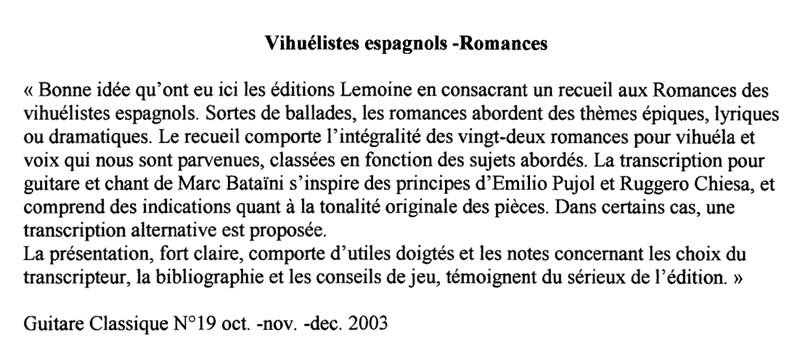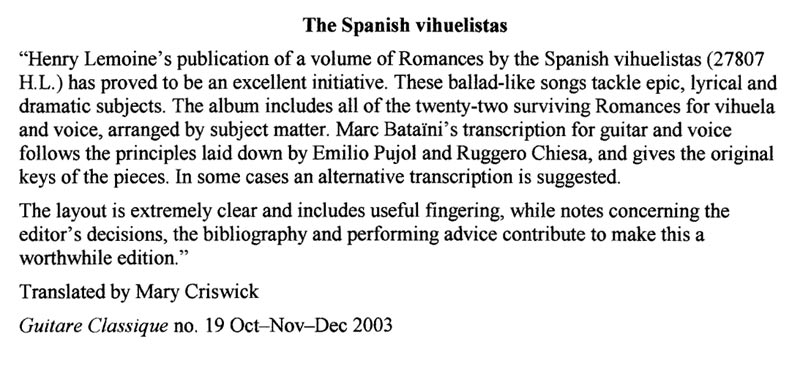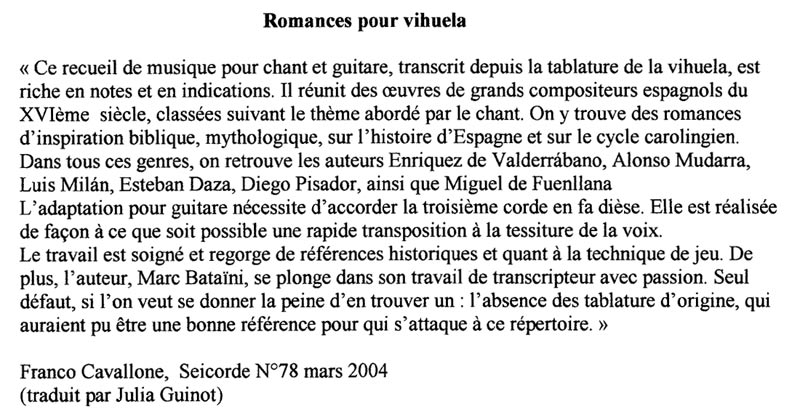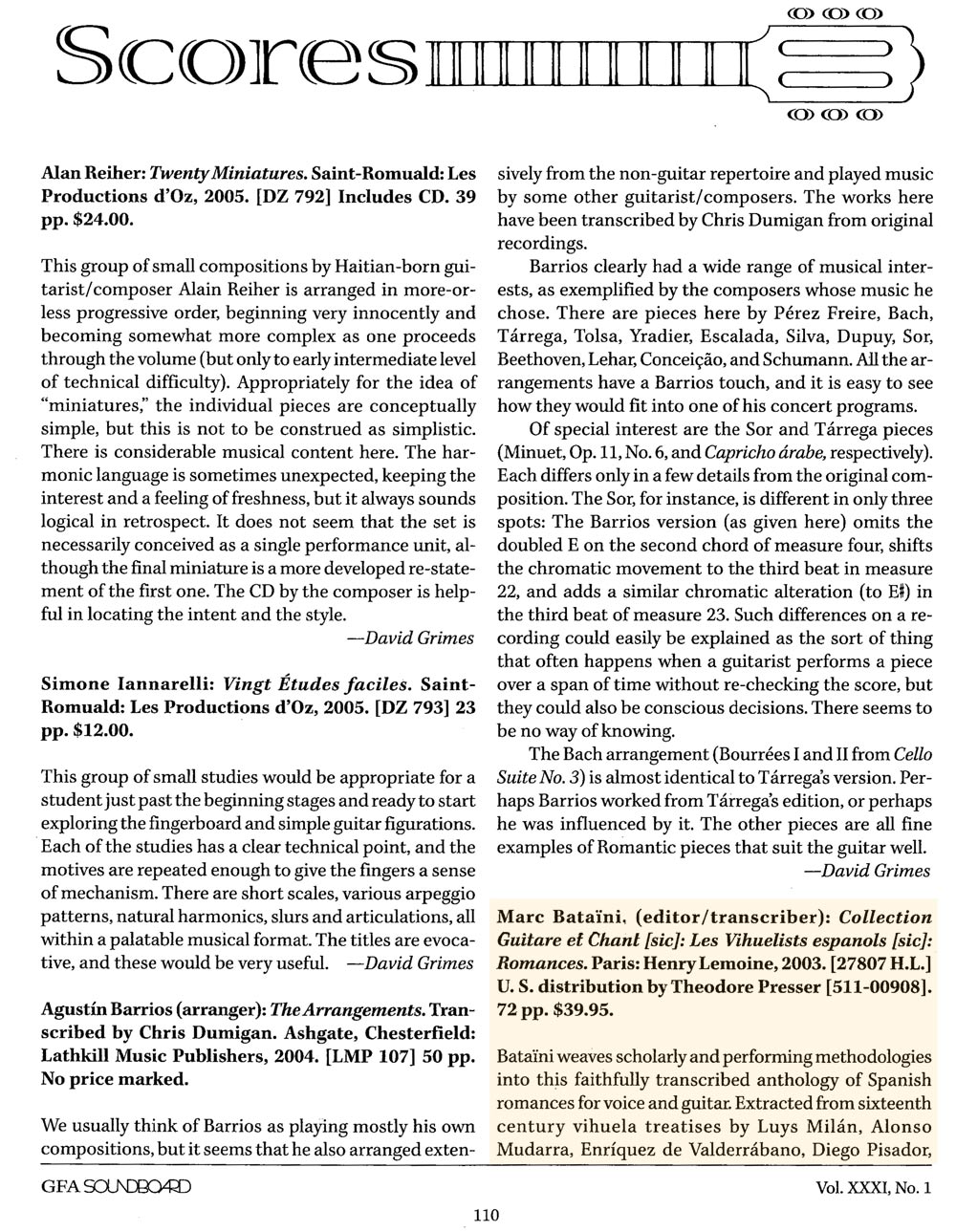CRITIQUES
El cant dells ocells
This is a tiny little arrangement of a Catalan Christmas song, possibly from the 17th Century. What a charming little piece this is. Set in D minor, but with a rich vocabulary of harmonies, there is something almost Dowland about this. The fourth guitar, tuned down to D, adds a depth and sustain over which Marc Bataïni has placed the tune and some nicely decorated inner parts whose style does not sit at all uncomfortably with the period of the piece.
This is a confident arrangement with an immediate fugal start to the piece, which always gets an audience’s attention. Thereafter, the tune appears an octave (and two players) further down, making a nice contrast. There is a thoughtful mix of long and short notes so that the piece has flow without feeling duttered.
Unlike many of D’Oz’s publications, there is information about the piece and there is copious fingering. There are no dynamics, but being a song, there would be many repetitions of the whole piece in a real performance.
The parts are, as is expected of this publisher, dear and easy on the eye.
For a teacher looking for something unusual for a Christmas concert, this could be just the thing.
Derek Hasted (Classical Guitar Magazine)
Renaissance italienne
C’est un manuscrit anonyme pour luth, datant du XVIe siècle et transcrit en notation moderne pour guitare par le musicologue italien Oscar Chilesotti (1848-1916), qui est à l’origine de ce recueil. Marc Bataïni y a choisi 6 pièces, qu’il a révisées librement afin de proposer des arrangements qui tombent sous les doigts, selon ses propres termes, plus guitaristiques en somme, tout en conservant les codes musicaux de la Renaissance. Au travail de retouche des notes proprement dit, s’ajoute tout un panel d’indications de nuances afin d’apporter un plus pour l’interprétation de ces oeuvres. Ces dernières sont des miniatures, mais ne vous fiez pas à ce format court : on est bien en présence de petits bijoux musicaux, magnifiés par le travail de révision de Marc Bataïni, qui permet de raviver la musique de la Renaissance au travers de la guitare moderne, sans tomber dans le désuet. On est donc en présence d’une véritable effort de restauration en somme, au-delà de la révision, ce qui ajoute encore plus de cachet à la « patine » des pièces originelles, que l’on a ainsi grand plaisir à les (re)découvrir.
Pascal Proust
Guitare Classique n°80 (mars-mai 2018)
Holborne, Anthony: Music for Lute and Bandora, Volume 1. Realization of tablatures by Oscar Cáceres and Marc Bataïni.
Anthony Holborne was a courtier; specifically, he was the Gentleman Usher to Her Majesty’s Privy Chamber (“Her Majesty” being Queen Elizabeth I. The Privy Chamber is where her Privy Council [cabinet] met-nothing to do with the other kind of privy.) He was an amateur musician who composed quite a lot of music for the lute, the bandora, and the cittern. Some years ago, Harvard University published his complete works in two volumes (now out of print) introducing Holborne to many in the lute world. His works for lute tend toward the thick-textured and stately. Even his dances that would ordinarily be sprightly -jigs and galliards-have a majestic feel. He played a lute with at least nine courses.
To shoehorn this music onto a guitar, Cáceres and Bataïni have used extensive scordatura . Almost every piece has a string or two tuned differently. They have chosen the pieces that work best in transcription and have been quite inventive in making them work. The music is worth learning, but trying to sight- read it is an exercise in humility. Recommended for advanced players.
Joseph Mayes, Soundboard Vol. 40 No. 2 – page 75
El noy de la Mare
here is another piece in the «Easy Music for 4 Guitars« series, and it’s a well-known one. So short is the arrangement that the bound full score is accompanied (pardon the pun) by three loose leaf full scores, which is rather neat because it allows players to swap parts on the repeats. The top line is entirely in fifth position, and the other three parts are all first position. Line two broadly shadows the tune three and six notes underneath, with occasional and effective sustained notes. Line three plays on beats one and three, whereas the bass plays on beats one and two, This interweaving of the accompaniment gives the music more of a feeling of continuity when played slowly. It’s a short review because it’s a short piece!
l’m not sure of the cover price, but if [the price] is a good one, the arrangement is certainly a good one to match.
Derek Hasted (Classical Guitar)
Musique élisabéthaine pour deux guitares
Here are six pieces from The Schoole of Musicke (1603) by Thomas Robinson, and five pieces by the ever-popular Anon!
All the pieces for both parts are for a 3rd string In F# mimicking the lute tuning but much of what you get is perfectly possible leaving the 3rd at G. However it is a much better option trying the 3rd to F# if you are not used to it, because it might lead you to being able to seamlessly move this music onto a lute, which is eminently more desirable.
So, you get The Queen’s Goodnight, the variation on a theme that is Twenty Ways Upon the Bells, A Plaine Song, Passamezzo Galliard. A Fantasy for Two Lutes, and A Toy for Two Lutes from the Robinson collection, followed by a Greensleeves set in 2/4, Robin (is to the Greenwood Gone), A Merry Mood, Mr Drewry’s Accords, and Bergamasca, all anonymous.
It is hard to go wrong with music such as this, it always sounds wonderful on guitars: although written for a more advanced pair of players, it can be attempted and moreover enjoyed by the less talented players. Worth putting on your shopping list.
Chris Dumigan (Classical Guitar Magazine)
Villanelles
A ‘villanelle’ is a kind of short rustic poem divided into verses that end in the same chorus, even when set to music as a song. The subject was usually pastoral, a simple ballad, which gave them a popular appeal. However, the regrouping of the songs by Marc Bataïni does not strictly obey the fixed scheme as outlined in the definition above. It was the scholar Jean-Baptiste Besard (circa 1567-circa 1625) a composer, lutenist, lawyer and doctor, who was the first person in 1603 to publish an anthology of Renaissance and early Baroque music in tablature. The volume was called Thesaurus Harmonicus, containing 403 instrumental works and songs by different composers, including some of Besard’s own. All the songs display the simple beauty that is present in the italian madrigals from the beginning of the Baroque period. They are suitable for a medium to medium low voice, and the standard would be grade IV and above. Most of the songs are short, only a page long with verses which use the same accompaniment. The songs are in italian, with no translation. They are grouped as Villanelles in one voice, and Villanelles in three voices. In this volume the scordatura tuning of the G string to F sharp is widely used, and the capo is recommended as a tool to find the best key for the vocalist. A few songs use regular tunings and these often have more sharps and are slightly higher in pitch. The standard for the guitarist is grade V and above, the music is set on the lower positions of the guitar, never traveling higher than fret five, with chords that connect easily. For the Singer the challenge would be the correct pronunciation of the italian language, and interpreting the style of the songs. The cover is made of stiff white card with a long red strip on the right hand side, on this back¬ground; the facsimile is displayed of the original cover of Thesaurus Harmonics. Marc Bataïni, an experienced transcriber, has freely adapted the tablature of Jean Baptiste Besard but he has taken a lot of care to retain the original features of the songs, while expanding the score to make the accompaniments more interesting to modern ears. He is keen to promote the repertoire that is available for guitar and voice from this period that is too rarely heard in live performance.
Sandra Hambleton Smith (Classical Guitar Magazine)
Ignacio Cervantes
Dans ce recueil, Marc Bataïni nous emmène dans Ille de Cuba de la fin du dix-neuvième siècle, avec ses transcriptions pour deux guitares de pas moins de douze danses du compositeur cubain Ignacio Cervantes (1847-1905), parmi les quarante qu’il écrivit pour piano. Au-delà du plaisir de la redécouverte de l’œuvre de Cervantes, le choix d’une adaptation pour duo de guitares est des plus judicieux, permettant de ce fait de rester au plus proche du texte originel (avec au besoin des changements de tonalités plus confortables pour la guitare, cela va de soi). La formule du duo va par ailleurs plus loin, en ajoutant un dialogue entre les deux guitares, dans lequel s’entremêlent les couleurs musicales propres à chacune — ce qui est évidemment déjà présent à l’origine entre les deux mains du pianiste, mais sur un même instrument. Marc Bataïni parvient à faire resplendir toute la richesse et l’exotisme de ces valses de Cervantes au travers de transcriptions brillamment élaborées, grâce auxquelles les couples de guitares n’en finiront plus de tournoyer ensemble.
Pascal Proust





